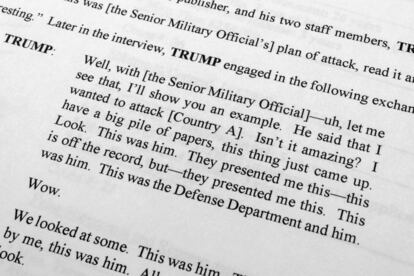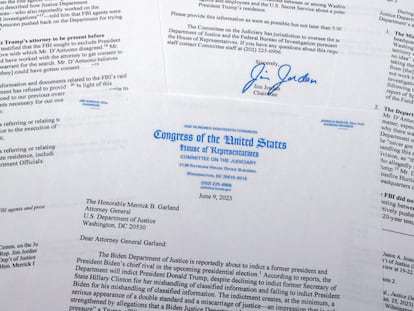Indictment takeaways: Trump’s alleged schemes and lies to keep secret papers
Justice Department prosecutors brought 37 felony counts against Trump in their indictment. An aide to Trump, Walt Nauta, was charged as a co-conspirator with six felony counts.

The federal indictment against Donald Trump accuses the former president of illegally hoarding classified documents at his Florida estate after leaving the White House in 2021, and then scheming and lying to thwart government efforts to recover them.
Justice Department prosecutors brought 37 felony counts against Trump in the indictment, relying upon photographs from Mar-a-Lago, surveillance video, text messages between staffers, Trump’s own words, those of his lawyers, and other evidence.
“It comes across as obviously a very strong case, if it can be proven,” said Mark Zaid, a Washington, D.C.-based lawyer who works on national security issues. “I’m surprised as to how personally involved it alleges Trump was with respect to the documents,” he added.
An aide to Trump, Walt Nauta, was charged as a co-conspirator with six felony counts.
Trump says he is innocent and has decried the criminal case — the second indictment against him in a matter of months — as an attempt by his political opponents to hinder his 2024 campaign. He is expected to make his first court appearance on Tuesday in Miami.
Here are key takeaways from the indictment unsealed Friday:
What are the charges?
Trump faces 31 counts of willful retention of national defense information under the Espionage Act. Other charges include: conspiracy to obstruct justice; corruptly concealing a document or record; concealing a document in a federal investigation; and making false statements.
Each of the willful retention counts pertains to a specific classified document found at Mar-A-Lago marked “SECRET” or “TOP SECRET.” Topics addressed in the documents include details about U.S. nuclear weapons, the nuclear capabilities of a foreign country and the military activities or capabilities of other countries.
The conspiracy charges deal with Trump’s alleged attempts to hide documents from his lawyer or federal investigators. The false statement charges stem from Trump causing his lawyer to tell the FBI that no more classified documents were at Mar-a-Lago — but then the FBI later found more than 100 documents during an August 2022 search.
The most serious charges carry potential prison sentences of up to 20 years each. But judges have discretion and, if convicted, first-time offenders rarely get anywhere near the maximum sentence. Being a former president would also likely be a major consideration in any sentencing.
What is the alleged conspiracy to obstruct justice?
The indictment accuses Trump and Nauta of conspiring to hide the secret documents from the grand jury, which in May 2022 issued a subpoena for him to turn them over.
The conspiracy allegation included a suggestion from Trump that his lawyer falsely tell investigators that the former president didn’t have any more classified documents at Mar-a-Lago. It also involved moving boxes to hide the secret documents from Trump’s lawyer, and suggesting that Trump’s lawyer hide or destroy documents that investigators were seeking.
The indictment says that, at Trump’s direction, Nauta moved about 64 boxes of documents from a Mar-a-Lago storage room to the former president’s residence in May 2022. He then returned “approximately 30 boxes” to the storage room on June 2 — the same day Trump’s legal team came to examine the boxes and search for classified documents to return to the government, the indictment says.
Nauta had a brief phone call with Trump before returning those boxes, the indictment says. Neither Trump nor Nauta told the former president’s lawyers that Nauta had moved any of the storage room contents, the indictment says.
Is Trump accused of sharing classified information?
The indictment alleges Trump showed classified documents to people who didn’t have security clearances on two occasions.
The court papers detail a meeting Trump had in July 2021 with a writer and publisher about an upcoming book. Trump told the pair “look what I found” and showed them what he described as a senior military official’s “plan of attack,” according to an audio recording of that conversation obtained by investigators.
Trump acknowledged during that meeting that the document was “highly confidential” and “secret information,” the indictment says. He also says that he could have declassified the document if he was still president.
“Now I can’t, you know, but this is still a secret,” he said, according to the indictment.
A few months later, Trump showed a representative of his political action committee a classified map of a foreign country while discussing a military operation in the country that was not going well, the indictment says. Trump acknowledged that he shouldn’t be showing the map to the person and told him not to get too close, prosecutors allege.
What evidence do prosecutors have?
In addition to the audio recording, prosecutors also relied upon text messages between Trump employees, photos of boxes of documents stored in various rooms throughout Mar-a-Lago and details about conversations between Trump and his lawyers that were memorialized by one of them.
In one conversation with his lawyers, Trump said: “I don’t want anybody looking through my boxes.” Trump also asked one of his lawyers if it would be better “if we just told them we don’t have anything here,” the indictment says.
Photographs in the indictment show boxes stacked on a stage in a ballroom as well as in a bathroom. Another shows boxes that spilled over in a storage room, including a document marked “SECRET/REL TO USA, FVEY,” which means information releasable only to members of the “Five Eyes” intelligence alliance of Australia, Canada, New Zealand, the United Kingdom and the United States.
Where will the case be heard?
While Trump’s first court appearance on Tuesday is expected to be in front of a magistrate judge in Miami, the case was filed in West Palm Beach — about 70 miles to the north. The case was assigned to Judge Aileen Cannon, a Trump appointee, who issued rulings favorable to him last year and expressed repeated skepticism of Justice Department positions.
Cannon was broadly criticized last year for granting the Trump legal team’s request for a special master to conduct an independent review of the hundreds of classified documents seized from his Florida property last year. The move, which temporarily halted core aspects of the Justice Department’s investigative work, was overturned months later by a three-judge panel of a federal appeals court.
Sign up for our weekly newsletter to get more English-language news coverage from EL PAÍS USA Edition
Tu suscripción se está usando en otro dispositivo
¿Quieres añadir otro usuario a tu suscripción?
Si continúas leyendo en este dispositivo, no se podrá leer en el otro.
FlechaTu suscripción se está usando en otro dispositivo y solo puedes acceder a EL PAÍS desde un dispositivo a la vez.
Si quieres compartir tu cuenta, cambia tu suscripción a la modalidad Premium, así podrás añadir otro usuario. Cada uno accederá con su propia cuenta de email, lo que os permitirá personalizar vuestra experiencia en EL PAÍS.
¿Tienes una suscripción de empresa? Accede aquí para contratar más cuentas.
En el caso de no saber quién está usando tu cuenta, te recomendamos cambiar tu contraseña aquí.
Si decides continuar compartiendo tu cuenta, este mensaje se mostrará en tu dispositivo y en el de la otra persona que está usando tu cuenta de forma indefinida, afectando a tu experiencia de lectura. Puedes consultar aquí los términos y condiciones de la suscripción digital.
More information
Archived In
Últimas noticias
Most viewed
- Reinhard Genzel, Nobel laureate in physics: ‘One-minute videos will never give you the truth’
- Oona Chaplin: ‘I told James Cameron that I was living in a treehouse and starting a permaculture project with a friend’
- Pablo Escobar’s hippos: A serious environmental problem, 40 years on
- Why we lost the habit of sleeping in two segments and how that changed our sense of time
- Chevy Chase, the beloved comedian who was a monster off camera: ‘Not everyone hated him, just the people who’ve worked with him’










































